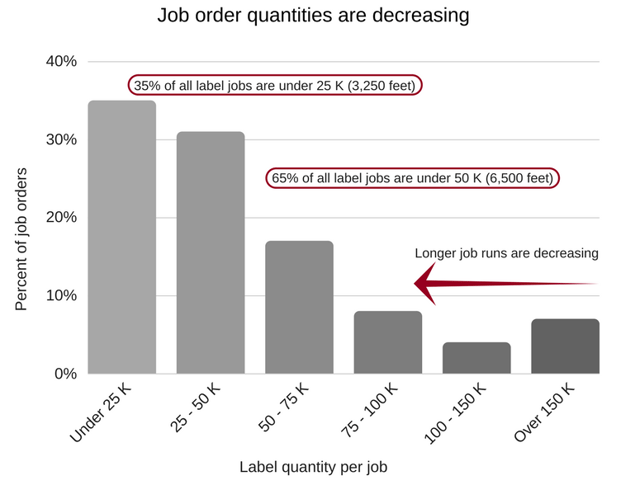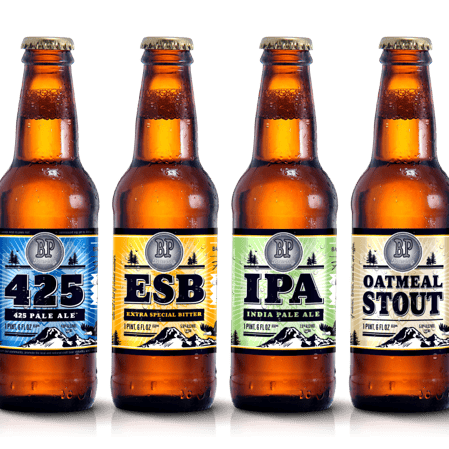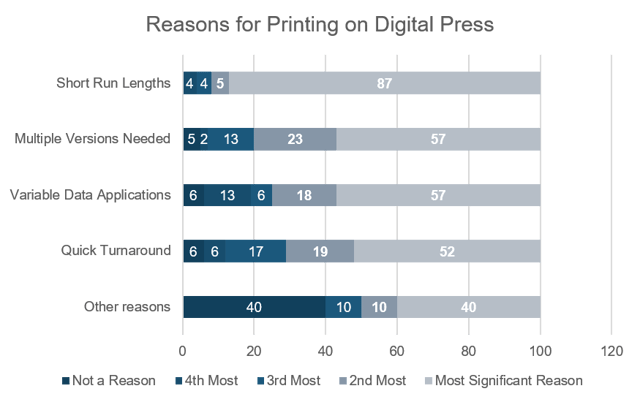Why Brand Owners are Demanding Shorter Run Lengths
More and more we hear converters talk about the pains of running short (and even micro!) runs for customers on traditional analog presses. With different definitions and interpretations, “short run” has become somewhat of an abstract topic and an industry buzzword. Do you classify on the basis of feet or units per job? Is it more profitable to run small quantity jobs flexo or digital? Within the walls of Mark Andy, we loosely define short run as a label, carton, or flexible packaging job under 10,000 feet.
Shorter runs are perfect candidates for hybrid technology production, giving the converter flexibility to fulfill low volume job orders without compromising on print quality, all with the added bonus of freeing up full-production flexo assets for jobs that make the most sense. While understanding the mechanics of short run and how to leverage it in your pressroom is great, many converters are still scratching their heads as to why their customers are demanding shorter run lengths. Read below to find out:
It’s Cost Effective
Our customers have observed a shift in brand orders adopting Just In Time (JIT) inventory principles. Generally accepted economies of scale within the label industry have changed, meaning customers require final product be delivered with shorter lead times and in much smaller quantities. Ordering fewer labels to match product demand is more cost effective for the brand owner, as basic business principles teach us that holding excess inventory is an additional risk. Neither party wants to assume the cost associated with holding extra label stock, making it critical for label printers to profitably support shrinking order sizes. With roughly 65% of the label work produced globally coming out under 6,500 feet, digital adoption and understanding of short run optimization is a must.

Unable to produce small-batch work and turn a profit, many converters produce short run jobs through their traditional analog workflow. Rolls of excess product sit on print shop shelves and converters cross their fingers that the customer will place another order without artwork modifications. Sounding familiar? We also hear too frequently the pains of having to outsource digital work to maintain customer satisfaction. It’s a risky business, and luckily there are various entry-level digital hybrid solutions – whether it be a flexible retrofit or approachable standalone press – to help converters leverage these short run jobs to their advantage.
SKU Proliferation
Product line extensions are more prevalent than ever, making SKU variety one of the top reasons labels are ordered and produced in smaller quantities. This is a direct result of consumer demand for multiple variations of familiar products.
Let’s use soda as an example. Any given day you’ll find a multitude of different sized beverages filling the shelves: minis,16 ounce, cans, and two-liters. That doesn’t begin to scratch the surface if you include the flavored adaptations: cherry, lime, vanilla, diet, and caffeine-free to name a few. The list can go on and on for just a single product line.

Inline hybrid technology allows you to take on these requests with ease. Rather than wasting time changing out flexo plates for each variation, on-the-fly changeovers with digital are your new best friend. Impress your customers with short turnaround work produced in a way that makes sense for your business and your bottom line.
Seasonal Goods Reign King
Modern brand owners are utilizing versioning to establish brand equity like never before. For instance, the first sign of fall is when pumpkin spice flavored everything hits the shelves. Around the holidays people flock to festively packaged goods.
Companies know this and leverage limited edition products with eye-catching packaging to boost sales. Seasonal packaging connects with the consumer on a deeper level that standard packaging can’t touch, enticing impulse buys through emotional appeal and flashy design. Due to the exclusivity and time-stamp associated with seasonal products, these are jobs that typically require smaller production quantities. Not to mention, brands are now connecting on a personal level by offering this highly personalized packaging.
To support these trending demands, digital printing provides it’s advantages to printers and converters while offering benefits to end customers.
Targeted Marketing and Product Testing
Brand owners are constantly evolving their product, looking for ways to increase sales and optimize their business. Much like you do as a label converter, and Mark Andy does as a technology provider. We all strive to be innovative and creative. When it comes to a consumer packaged goods (CPGs for short), packaging is a great way for a product to be more relevant.
The 2000’s have been an age of customization, making personalized products a common desire of the contemporary consumer. Individuals can go to the store and find water bottles with their local sports team on it or their name on a soft drink. This has transformed the modern packaging landscape, making short run even more necessary in support of specialized packaging and promotional labeling. Hybrid digital printing technologies are an attractive solution to profitably support converters seeking opportunities in this arena.
Final Thoughts
Printers and converters who understand the short run environment and brand owner rationale are able to earn more business. Period. They are enabled to go after work they didn’t think was possible, and are open to investing in the right technology to support their growing short run needs.

Instead of being plagued with downtime and changeovers on your flexographic press, start running your smaller jobs digitally. At Mark Andy, our digital hybrid solutions fit any book of business, and help converters keep their flexo presses running jobs that make the most sense and are most profitable.